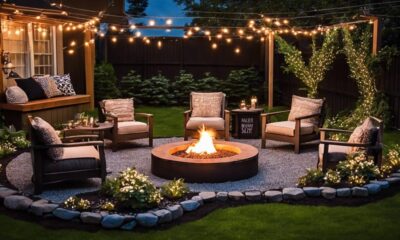Architecture Home Styles
How to Achieve a Minimalist Design on a Cheap Budget
Sculpt your living space on a shoestring budget by learning the savvy secrets to achieving a minimalist design that's both stylish and affordable.
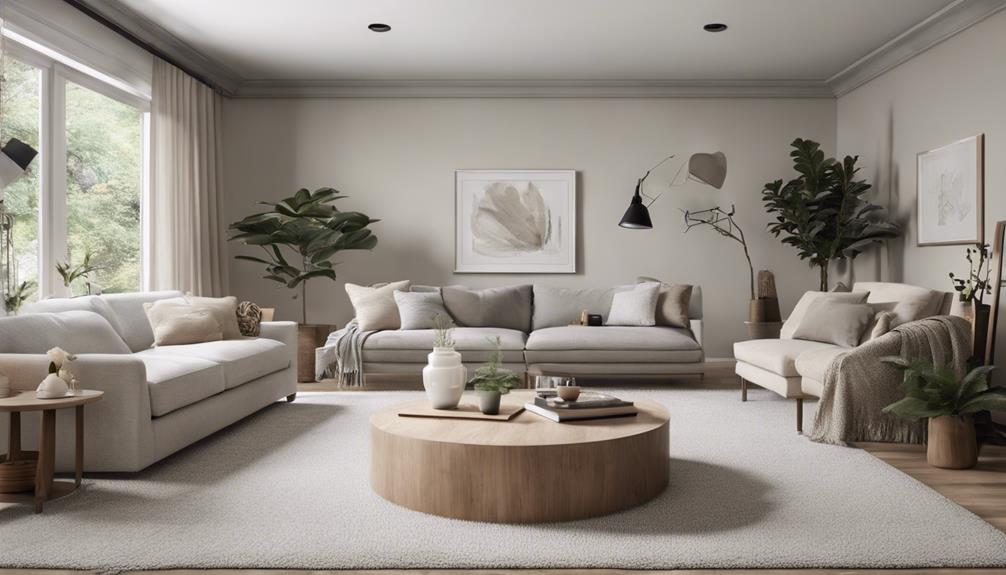
When crafting a minimalist design on a tight budget, think of it as sculpting a masterpiece from a block of marble – it's about chiseling away the excess to reveal the beauty within.
But how can we achieve such elegance without draining our wallets? Let's explore practical yet stylish ways to streamline our living spaces while keeping costs low, unlocking the secrets to achieving a minimalist aesthetic that speaks volumes without overspending.
Key Takeaways
- Opt for cost-effective materials like plywood and unfinished wood for budget-friendly minimalist decor.
- Prioritize decluttering, neutral color palettes, and quality pieces for an affordable minimalist design.
- Utilize DIY projects, upcycling, and thrifting for personalized and budget-friendly minimalist decor.
- Maximize space with multi-functional furniture, minimalist storage solutions, and monochrome color schemes.
Budget-Friendly Minimalist Decor Ideas
When designing a minimalist space on a budget, opt for simple materials like plywood to achieve a cost-effective yet stylish decor. Plywood isn't only affordable but also versatile, allowing you to create sleek furniture pieces that fit perfectly into a minimalist design. Choose furniture without elaborate details; this not only keeps costs low but also maintains the clean and simple aesthetic of a minimalist space. Consider using unfinished woods for a budget-friendly look that adds a touch of natural warmth to your decor.
To keep your minimalist design budget-friendly, opt for straightforward lighting fixtures. These fixtures aren't only cost-effective but also contribute to the overall simplicity of the space. Showcase pieces with clean, minimalist designs to achieve an affordable yet stylish look. By focusing on simple materials, furniture, and lighting, you can create a minimalist space that exudes sophistication without breaking the bank.
Essential Tips for Minimalist Design
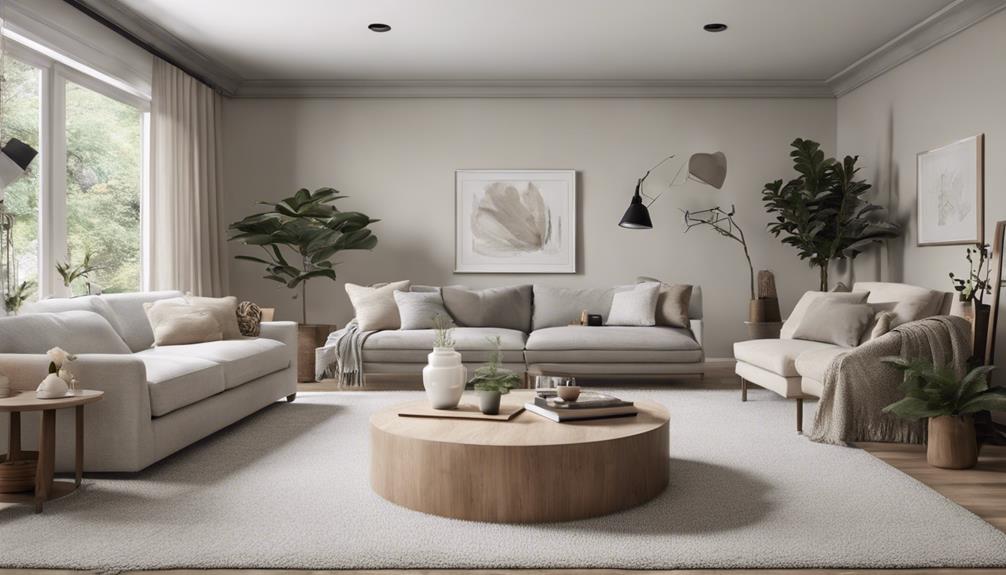
For achieving a minimalist design that radiates simplicity and elegance, prioritizing decluttering and embracing a neutral color palette is key.
When aiming for a minimalist design on a budget, opt for budget-friendly options like decluttering your space to create a clean canvas. Choose a neutral color palette of whites, grays, or beiges to establish a calming atmosphere while keeping costs low.
Investing in quality pieces made from durable materials such as wood and linen ensures longevity without breaking the bank. Embrace negative space to accentuate essential elements and create an open, airy feel within your space.
Strategic lighting can enhance the ambiance and make the room feel welcoming without the need for expensive fixtures. By focusing on decluttering, selecting quality pieces, utilizing negative space, and optimizing lighting, achieving a minimalist design on a budget isn't only feasible but can also result in a stylish and sophisticated living space.
DIY Minimalist Home Projects
To embark on our journey into DIY Minimalist Home Projects, let's explore how repurposing existing materials and creatively upcycling can infuse a unique and budget-friendly charm into your minimalist design.
- Repurpose with Purpose: Look around your home for items that can be repurposed into minimalist decor pieces. An old wooden ladder can be transformed into a stylish bookshelf or a plant stand.
- Upcycle for a Fresh Look: Give new life to old furniture by painting it in a sleek, monochromatic color scheme. A dated dresser can become a chic storage unit with a simple coat of paint and new hardware.
- Transform Your Space Creatively: Use minimalist principles to declutter and organize your space. Consider DIY projects like creating floating shelves to display essential items while keeping surfaces clear and open.
- Customize on a Budget: Embrace the opportunity to customize and personalize your living space through DIY projects. Simple touches like handmade wall art or customized storage solutions can elevate your minimalist design without breaking the bank.
Maximizing Space With Minimalist Design
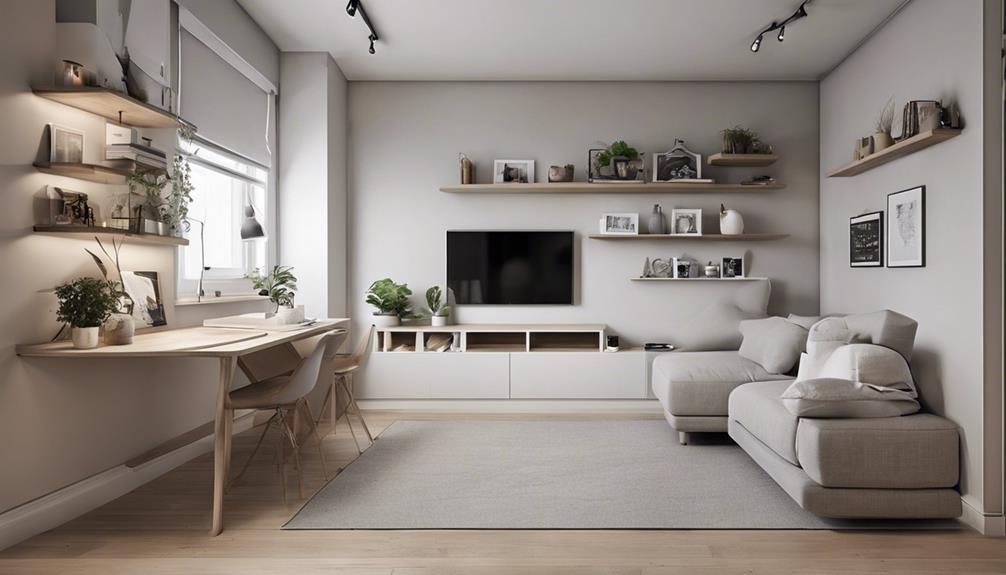
Utilizing multi-functional furniture is key to maximizing space efficiently within a minimalist design. When aiming to optimize space in a budget-friendly manner, consider storage solutions such as ottomans with hidden compartments. These not only reduce clutter but also enhance the available space. Opting for sleek minimalist shelving units can help display items while maintaining an organized and spacious environment. Additionally, incorporating wall-mounted shelves can free up floor space, contributing to a clean and minimalist aesthetic.
To achieve a minimalist look without breaking the bank, choose furniture with clean lines and a minimalist design. This selection creates an open and airy feel, even in smaller spaces. By strategically placing multi-functional pieces, embracing storage solutions, and integrating minimalist shelving options, you can make the most of your space while adhering to a budget-friendly approach. Remember, creating a minimalist design isn't about sacrificing functionality but rather about cleverly maximizing every inch available.
Thrifty Minimalist Decorating Strategies
Exploring thrift stores and online marketplaces can uncover budget-friendly furniture options for thrifty minimalist decorating strategies. When aiming for a minimalist design on a budget, consider the following tips:
- DIY Projects and Upcycling: Get creative by repurposing items or transforming old pieces into stylish decor. This approach not only adds a personal touch to your space but also helps in saving money.
- Opt for Minimalist Wall Art or Simple Plants: Embrace the simplicity of minimalist wall art or add a touch of greenery with easy-to-care-for plants. These elements can enhance the aesthetic of your space without breaking the bank.
- Practice Mindful Consumption: Avoid impulse purchases and focus on buying only what you truly need. By being mindful of your spending habits, you can prioritize essential items and stick to your budget.
- Maintain Organized Spaces: Keep your living areas clutter-free by designating specific storage solutions for your belongings. An organized space not only contributes to a minimalist aesthetic but also promotes a sense of calm and clarity in your home.
Achieving Minimalism Through Repurposing

Let's get creative with repurposing to achieve a minimalist look without breaking the bank.
By thinking outside the box and giving new life to old items, we can infuse our spaces with charm and individuality.
Embracing repurposing as a budget-friendly design strategy allows us to transform the ordinary into the extraordinary.
Repurpose With Purpose
To achieve minimalist design on a budget, repurposing with purpose breathes new life into old items, promoting sustainability and creativity in your decor. Here's how you can make the most of repurposing:
- Save Money: Utilize existing items creatively to avoid unnecessary expenses.
- Reduce Waste: Repurposing promotes sustainability by giving old items a new purpose.
- Create Cohesive Space: Use repurposed furniture, accessories, and decor items to maintain a harmonious aesthetic.
- Be Intentional: Repurpose wisely to curate a minimalist space that reflects your style without overspending.
Budget-Friendly Minimalist Hacks
Repurposing old items not only adds character to your space but also plays a crucial role in achieving a budget-friendly minimalist design. By incorporating DIY projects and getting thrifty with your decor choices, you can save costs while creating a stylish and organized living environment. Consider repurposing old furniture with a fresh coat of paint or new hardware to fit a minimalist aesthetic. Get creative with versatile storage solutions like using baskets, bins, and wall hooks to declutter inexpensively. You can also shop at thrift stores or garage sales for budget-friendly minimalist decor pieces. Think outside the box and repurpose items like mason jars as candle holders or old frames as minimalist wall art to achieve a chic look without breaking the bank.
| Budget-Friendly Minimalist Hacks | Benefits |
|---|---|
| Repurpose old furniture | Adds character and saves costs |
| DIY projects | Customization and creativity |
| Versatile storage solutions | Decluttering and organization |
Simple Transformations for Less
Transforming everyday items with a touch of creativity can lead to stunning minimalist makeovers without straining your budget.
- Repurpose old furniture by painting it with a neutral color for a modern minimalist look.
- Use thrift store finds to add unique pieces to your home decor without breaking the bank.
- Transform wooden crates into stylish storage solutions for a minimalist and organized living space.
- Give old vases or jars a new purpose as minimalist decor accents, adding a touch of elegance to your design.
Simple Solutions for Minimalist Living
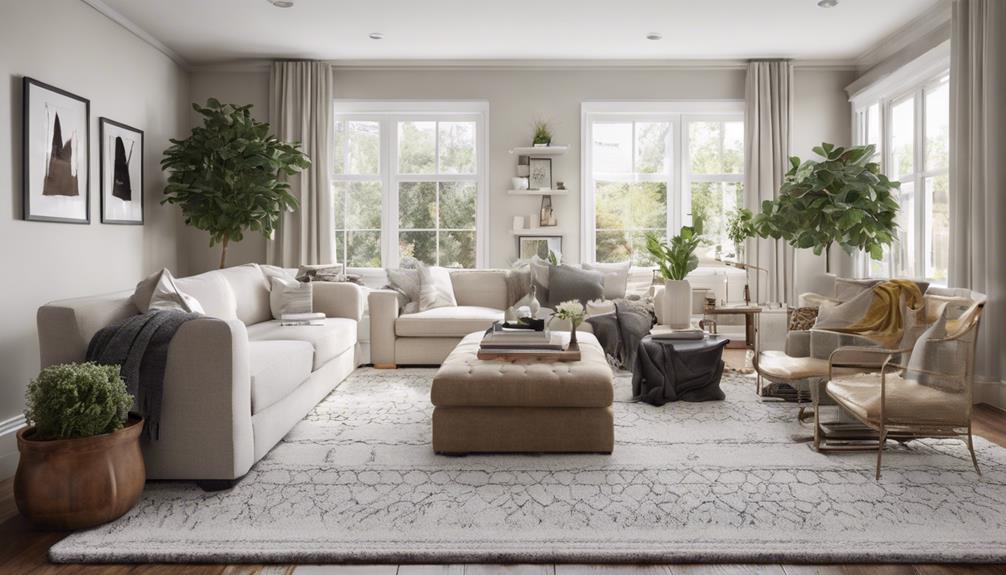
Let's simplify our living spaces by decluttering, making functional furniture choices, and sticking to monochrome color schemes. By focusing on these points, we can achieve a minimalist lifestyle that's both budget-friendly and aesthetically pleasing.
Embracing simplicity in our design choices won't only create a serene environment but also promote a sense of calm and order in our everyday lives.
Decluttering for Minimalist Living
When embarking on minimalist living, the first step is to efficiently declutter your space by identifying and letting go of items that lack purpose or sentimental value. Here are four simple solutions for achieving a clutter-free and minimalist design on a budget:
- Assess your belongings to determine essentials for a minimalist lifestyle.
- Donate or sell items that lack purpose or sentimental value to declutter effectively.
- Prioritize items that bring value and joy to your life before decorating your space.
- Simplify your surroundings by keeping only what's truly needed and loved for a minimalist design.
Functional Furniture Choices
To seamlessly continue the journey towards minimalist living, we now turn our focus to selecting functional furniture choices that align with the principles of simplicity and practicality.
When choosing furniture pieces for a minimalist design on a budget, opt for clean lines and simple designs that maintain the aesthetic you desire. Look for multi-functional furniture that serves more than one purpose, especially in small spaces. Consider cost-effective options like second-hand or DIY furniture to stay within your budget while still achieving a minimalist look.
Additionally, prioritize minimalist storage solutions to keep clutter at bay and maintain a clean and organized living space. By selecting essential furniture items that emphasize functionality and simplicity, you can create a minimalist oasis without breaking the bank.
Monochrome Color Schemes
Embracing monochrome color schemes is a foundational step towards achieving a minimalist living space with a clean and cohesive aesthetic.
- Monochrome palettes, like shades of black, white, or gray, create a minimalist look effortlessly.
- These schemes provide an uncluttered space, making rooms feel more spacious and organized.
- Opting for monochrome colors is budget-friendly, mainly involving painting walls with a single hue and using minimal decor accents.
- Monochrome color schemes are versatile, easily adaptable to various design styles, from modern to Scandinavian.
Frequently Asked Questions
How Do You Build a Minimalist Home on a Budget?
Creating a minimalist home on a budget requires strategic choices. We can achieve this by:
- Decluttering
- Choosing neutral colors
- Investing in quality, timeless pieces
Embracing negative space and using lighting effectively helps create an open and inviting atmosphere. By being intentional with our design decisions, we can achieve a minimalist aesthetic without breaking the bank.
Is Minimalist Design Cheaper?
Yes, minimalist design is generally cheaper due to its focus on simplicity and functionality. Opting for essential pieces over decorative items can significantly reduce costs. Decluttering and reusing existing items are common practices in minimalist design, minimizing the need for new purchases.
Choosing neutral colors and clean-lined furniture maintains a minimalist style while being cost-effective. Embracing negative space and simplicity in decor can help achieve a minimalist design on a budget.
What Is a Minimal Living Budget?
A minimal living budget involves spending intentionally on essential items, prioritizing quality over quantity. It focuses on creating a functional living space by decluttering and simplifying possessions to reduce unnecessary expenses.
How Do You Create a Minimalist Design?
Creating a minimalist design involves decluttering, choosing neutral colors, investing in quality pieces, embracing negative space, and using lighting strategically.
By focusing on essentials and simplicity, we can achieve a calming and spacious atmosphere in our living spaces. With intentional design choices, we can highlight key elements and create a timeless and inviting environment.
It's about prioritizing what truly matters and letting go of the unnecessary to achieve a minimalist aesthetic.
Conclusion
In the end, achieving a minimalist design on a budget is like painting a masterpiece with just a few brushstrokes. By embracing simplicity, utilizing what you have, and incorporating cost-effective solutions, you can create a space that's both stylish and budget-friendly.
Remember, less is more, and with a little creativity and resourcefulness, you can transform your home into a peaceful sanctuary that reflects your minimalist vision.
So embrace the beauty of simplicity and watch your space shine!
- About the Author
- Latest Posts
Introducing Ron, the home decor aficionado at ByRetreat, whose passion for creating beautiful and inviting spaces is at the heart of his work. With his deep knowledge of home decor and his innate sense of style, Ron brings a wealth of expertise and a keen eye for detail to the ByRetreat team.
Ron’s love for home decor goes beyond aesthetics; he understands that our surroundings play a significant role in our overall well-being and productivity. With this in mind, Ron is dedicated to transforming remote workspaces into havens of comfort, functionality, and beauty.
Architecture Home Styles
How to Have a Tiny Home in Arizona: Your Essential Guide
Fascinated by the idea of a tiny home in Arizona? Discover how tax considerations can impact your journey in this essential guide.
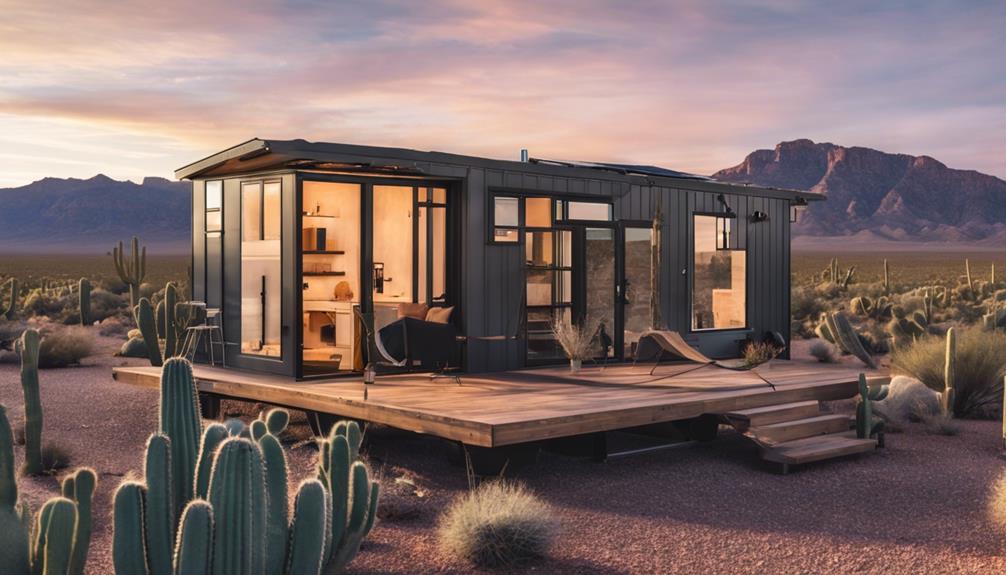
Embarking on the journey of having a tiny home in Arizona is like navigating through a desert oasis, each step revealing new insights and challenges. From understanding the intricate web of zoning laws to discovering the perfect location that aligns with your tiny living dreams, this essential guide equips you with the knowledge needed to turn your tiny home vision into reality.
But what about the unique tax considerations that come with owning a tiny home in Arizona? Stay tuned to uncover key insights that will make a difference in your tiny home journey.
Key Takeaways
- Understand Arizona zoning laws for placement in suitable zones.
- Seek permits for tiny homes based on location and structure type.
- Explore tax benefits for tiny homeowners through property tax exemptions.
- Build a supportive community through local groups and events for guidance.
Zoning Laws and Regulations in Arizona
When navigating the realm of tiny home living in Arizona, understanding the intricacies of zoning laws and regulations becomes paramount. In Arizona, zoning laws permit tiny houses on foundations in multifamily, detached single-family, and accessory dwelling unit zones.
However, for Tiny Homes on Wheels, they're typically classified as recreational vehicles and must adhere to specific parking regulations within designated zones. Maricopa County has established particular regulations for tiny houses, including constraints on the floor area allowed for permanent structures. On the other hand, Pima County imposes restrictions on Tiny Homes on Wheels through specific codes that govern their placement.
The zoning options for tiny houses in Arizona encompass various zones such as isolated single-family zones, accessory dwelling unit zones, and multifamily zones. Familiarizing oneself with these zoning laws and regulations is crucial for anyone considering embarking on the adventure of tiny home living in Arizona.
Ideal Locations for Tiny Homes
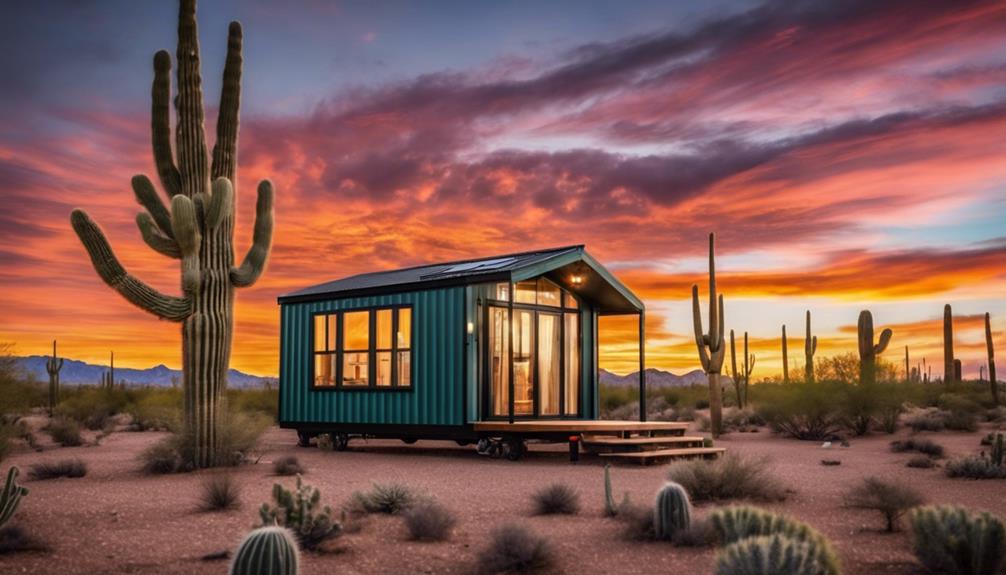
For those seeking ideal locations to establish their tiny homes in Arizona, cities like Phoenix, Tucson, Sedona, and Lakeside present attractive options. When considering where to set up your tiny home in Arizona, keep in mind that Pima County and Coconino County permit the establishment of tiny houses in specific zones. In these areas, tiny homes can be placed in isolated single-family zones, ADU zones, and multifamily zones. For those with tiny houses on wheels, it's important to note that they must be parked in designated R.V. zones in compliance with regulations.
- Phoenix, Tucson, Sedona, and Lakeside are ideal cities for setting up tiny homes in Arizona.
- Pima County and Coconino County allow tiny houses in specific zones.
- Tiny homes can be placed in single-family zones, ADU zones, and multifamily zones.
- Tiny houses on wheels must adhere to regulations in designated R.V. zones.
Tax Considerations for Tiny Home Owners
Exploring the tax implications of owning a tiny home in Arizona reveals potential benefits and considerations that can significantly impact financial planning for homeowners. Tiny home owners in Arizona may qualify for property tax exemptions based on factors like square footage and adherence to green building standards. Additionally, the size of tiny homes could lead to reduced property tax assessments in certain counties. It is crucial for Arizona tiny home owners to familiarize themselves with local tax laws to take advantage of any available tax benefits. Seeking guidance from a tax professional or local tax assessor can provide valuable insights into how owning a tiny home in Arizona may influence property taxes.
Tax Considerations for Tiny Home Owners:
| Key Points | Details | Importance |
|---|---|---|
| Property Tax Exemptions | Available based on square footage and green standards | Maximize Savings |
| Reduced Assessments | Smaller homes could mean lower tax bills | Financial Advantage |
| County Variances | Regulations differ, impacting tax benefits | Local Compliance |
| Professional Advice | Consult with tax professionals for guidance | Optimal Planning |
Finding Community Support in Arizona

By actively engaging with local resources and networking opportunities, tiny home enthusiasts in Arizona can establish a strong sense of community support to enhance their living experience.
Here are some ways to find community support in Arizona:
- Join local Facebook groups like 'Arizona Tiny House Community' for a supportive network.
- Attend tiny house meetups and events in Arizona to connect with like-minded individuals.
- Explore tiny house workshops and seminars in the state to gain knowledge and resources.
- Consider volunteering with non-profit organizations focused on sustainable living and tiny house advocacy in Arizona.
These opportunities not only provide a sense of belonging within the tiny house community but also offer valuable insights, resources, and support for those embracing the tiny home lifestyle in Arizona.
Engaging with these avenues can enrich your experience, foster connections, and empower you to navigate the challenges and joys of sustainable living in the state.
Building and Parking Tips for Tiny Homes
Engaging with the regulations and guidelines for building and parking tiny homes in Arizona is crucial for ensuring compliance and a smooth transition into sustainable living. Tiny homes on foundations in Arizona must adhere to the 2018 IRC Appendix Q requirements, which outline specific space dimensions and safety features to guarantee structural integrity.
Building a tiny home on skids offers a semi-permanent placement option while still allowing for mobility if relocation becomes necessary. For those opting for tiny homes on wheels, meeting mobile home requirements is essential, and a minimum of 160 square feet is required for parking.
The flexibility in setting up tiny homes in various zone types in Arizona provides diverse housing options based on individual preferences. Tiny houses on wheels are particularly popular for their mobility and flexibility, making them an attractive choice for those desiring a minimalist lifestyle without sacrificing comfort.
Frequently Asked Questions
Can I Put a Tiny House on My Property in Arizona?
Yes, we can put a tiny house on our property in Arizona if it complies with local zoning regulations. Different options like multifamily, detached single-family, or accessory dwelling units are available. Land near Maricopa City, Pinal County, offers accessible placement.
How Much Does a Tiny House Cost in Az?
Tiny houses in Arizona can range from $20,000 to $200,000 depending on size and customization. DIY kits start at $8,000, but labor costs add up. Land, utilities, and permits are extra. Building a tiny house can be a cost-effective housing choice.
What Is the Minimum Square Footage for a House in Arizona?
In Arizona, the minimum square footage for a house varies based on its foundation type. For tiny houses on foundations, it's 200 square feet, while those on trailers require at least 160 square feet. Adhering to building codes is essential.
Does Arizona Have a Tiny Home Community?
We do have tiny home communities in Arizona. These communities provide shared amenities, community engagement, and a supportive environment. Living in a tiny house community offers a unique sense of belonging, shared resources, and a close-knit experience.
Conclusion
In conclusion, navigating the world of tiny homes in Arizona may seem like a daunting task, but with the right resources and community support, it can be a breeze.
From zoning laws to building tips, we've covered it all in our essential guide.
So go ahead, take the leap into tiny home living and watch your dreams of a cozy, sustainable lifestyle come to life in the Grand Canyon State!
- About the Author
- Latest Posts
Introducing Ron, the home decor aficionado at ByRetreat, whose passion for creating beautiful and inviting spaces is at the heart of his work. With his deep knowledge of home decor and his innate sense of style, Ron brings a wealth of expertise and a keen eye for detail to the ByRetreat team.
Ron’s love for home decor goes beyond aesthetics; he understands that our surroundings play a significant role in our overall well-being and productivity. With this in mind, Ron is dedicated to transforming remote workspaces into havens of comfort, functionality, and beauty.
Architecture Home Styles
Exploring the Difference Between Traditional and Classic Design
Kickstart your journey into the world of design by uncovering the subtle yet significant distinctions between traditional and classic styles, shaping your perception of timeless elegance.

When considering traditional versus classic design, we uncover nuanced distinctions in style and aesthetic preferences. The interplay between historical influences and contemporary interpretations provides a fascinating insight into the evolution of design principles.
As we explore the intricate details and subtle nuances that set these two styles apart, it becomes evident that each offers a unique perspective on elegance and sophistication.
Stay tuned to unravel the intricacies that define the essence of traditional and classic design, shedding light on the nuances that shape our perception of timeless aesthetics.
Key Takeaways
- Traditional design features bold colors and intricate patterns, while classic design opts for soft and subdued colors for elegance.
- Both traditional and classic design styles focus on creating a balanced, inviting, and harmonious atmosphere.
- Traditional furniture embodies moderation and balance with solid wood, while classic furniture exudes nobility with gilded finishes.
- Lighting in traditional design aims for warmth and coziness, while classic design creates a luxurious ambiance with ornate fixtures.
Key Elements in Traditional Design
In traditional design, we intricately weave together elements of moderation, elegance, and balance to create a timeless aesthetic inspired by the rich European design traditions of the 18th and 19th centuries. Solid wood plays a pivotal role in this style, exuding warmth and coziness throughout the space. The choice of fabrics like cotton, leather, and velvet further enhances the comfort aspect, inviting you to sink into luxurious textures. Lighting is carefully curated to emanate a soft and inviting glow, achieved through the use of ambient sources such as table lamps and floor lamps, setting a cozy ambiance.
The color palette in traditional design is a symphony of rich colors like deep reds, lush greens, and vibrant yellows, adding depth and character to the space. These hues evoke a sense of opulence and sophistication, harmonizing beautifully with the overall design scheme. The blend of these elements creates a space that not only exudes elegance but also envelops you in a sense of comfort and luxury.
Characteristics of Classic Design

Transitioning from the rich tapestry of traditional design, classic design embodies a timeless allure through its emphasis on neutral hues, enduring furniture pieces, and ageless patterns. Classic design is about creating a space that feels elegant and sophisticated, never going out of style. This style incorporates traditional furniture pieces like wingback chairs and claw-foot tables, showcasing intricate details and a focus on symmetry. Antique or vintage items are often integrated into classic interiors to enhance the sense of heritage and history. Natural materials such as wood and marble play a significant role in classic design, adding a touch of authenticity and luxury. The use of neutral colors like beige, ivory, and taupe creates a serene and calming atmosphere, perfect for those who appreciate a refined aesthetic. Classic design is about capturing the essence of timeless beauty and creating a space that exudes grace and elegance.
| Characteristics | Description | Example |
|---|---|---|
| Neutral Colors | Create a serene atmosphere | Beige, Ivory, Taupe |
| Traditional Furniture | Emphasize heritage and sophistication | Wingback chairs, Claw-foot tables |
| Intricate Details | Showcase fine craftsmanship | Ornate carvings, Embossed patterns |
| Natural Materials | Add authenticity and luxury | Wood, Marble, Leather |
| Timeless Patterns | Enhance the sense of elegance | Damask, Toile, Houndstooth |
Color Palette Variances
Let's delve into the captivating interplay of colors in traditional and classic design, unveiling their distinct palettes and the emotions they evoke within interior spaces.
Traditional design is known for its bold use of color, incorporating rich tones like red, green, and yellow to create a lively and accented color palette. In contrast, classic design opts for a more subdued approach, favoring neutral and soft colors that convey timeless sophistication and elegance. Both styles share a common emphasis on proportion and harmony when selecting colors, ensuring a visually pleasing aesthetic within the space.
Classic design often showcases prestigious materials with subtle contrasts, exuding an air of understated luxury. On the other hand, traditional design tends to embrace vibrant colors and intricate patterns, adding a sense of energy and warmth to the room. The careful selection of color palettes in traditional and classic design plays a vital role in shaping the overall ambiance and character of the interior, showcasing a harmonious blend of elegance, proportion, and timeless sophistication.
Differences in Furniture Styles

Embarking on a journey through the realm of interior design, we are met with a striking divergence in furniture styles between traditional and classic design aesthetics. Traditional furniture in European design, originating from the 18th and 19th centuries, embodies moderation, elegance, and balance. On the other hand, classic furniture exudes noble atmospheres with pomposity, showcasing prestigious materials like oak, mahogany, ceramic, marble, gold, and silver finishes.
| Traditional Furniture | Classic Furniture |
|---|---|
| Rooted in European design | Exudes ethereal nobility |
| Favoring moderation | Prestigious materials |
| Warmth and coziness | Gilded and opulent |
In traditional style, harmony is achieved through blending various elements, offering warmth and coziness with solid wood furniture and fabrics like cotton, leather, and velvet. In contrast, classic style features gilded finishes and gold leaf for a luxurious look, emphasizing richness and opulence. These styles also extend into lighting design, with traditional opting for warmer and softer lighting, creating a cozy feel with ambient lighting solutions like table lamps and floor lamps, while classic style leans towards ornate chandeliers and sconces for a grandiose touch.
Lighting Design Variances
As we delve into the realm of lighting design variances, a captivating interplay emerges between classic and traditional interior styles, each illuminating spaces with unique charm and character. Classic design exudes richness and opulence through lighting fixtures like grand chandeliers and intricately detailed sconces. These ornate details in classic lighting fixtures create a luxurious ambiance, evoking a sense of grandeur and sophistication within a space.
On the other hand, traditional design takes a softer approach, opting for warmer and cozier lighting solutions such as table lamps and floor lamps. The emphasis in traditional design is on creating a welcoming and comfortable environment, where ambient lighting plays a pivotal role in setting the mood. This style aims to promote a sense of intimacy and relaxation, steering away from the grandiose nature of classic design.
Both classic and traditional design styles strive for elegant lighting options that not only serve a functional purpose but also enhance the overall ambiance of a room. Whether it's the opulence of classic chandeliers or the cozy feel of traditional table lamps, lighting design plays a crucial role in shaping the character of a space.
Frequently Asked Questions
How Is Traditional Design Different From Modern Design?
Traditional design differs from modern design in various aspects.
We see traditional design focusing on warmth and rich colors like red and green, while modern design emphasizes sleek lines and minimalism.
Traditional design incorporates natural materials like wood for a cozy atmosphere, whereas modern design utilizes innovative materials for a contemporary look.
The former favors classic furniture with intricate details, while the latter features unique furniture and cutting-edge designs.
What Is the Definition of Traditional Design?
When it comes to traditional design, it's like stepping into a cozy retreat filled with elegant charm. Rich colors like red, green, and yellow dance together, creating a lively palette.
Classic lines and solid wood furniture greet you warmly, while fabrics like cotton and velvet whisper comfort and luxury. It's a timeless style that wraps you in a familiar embrace, making every corner of your home feel like a cherished memory.
What Is the Difference Between Modern Design and Classic Design?
When it comes to modern design and classic design, the distinction lies in their contrasting aesthetics.
Modern design embodies sleek lines and cutting-edge materials, reflecting a contemporary and innovative vibe.
In contrast, classic design exudes elegance and timeless sophistication with its traditional furniture and luxurious details.
These two styles offer a unique blend of old-world charm and futuristic elements, catering to different tastes and preferences in the world of design.
What Is the Difference Between Modern and Classic Home Design?
When it comes to modern and classic home design, the distinction lies in their essence.
Modern design embodies innovation and creativity with sleek lines and cutting-edge materials, ideal for those seeking a contemporary aesthetic.
Classic design, on the other hand, exudes elegance and sophistication through timeless pieces and intricate details, appealing to those who value tradition and refinement in their living spaces.
These contrasting styles offer unique choices for expressing personal taste and style preferences.
How Does Traditional Design Differ from Classic Design in Terms of Aesthetics and Functionality?
Traditional design encompasses a more ornate and intricate aesthetic, while classic design focuses on simplicity and elegance. In terms of functionality, traditional design often prioritizes practicality, while classic design may incorporate more decorative elements. The main difference between modern design and traditional design lies in their approach to aesthetics and practicality.
Conclusion
As we wrap up our exploration of traditional and classic design, it's clear that these styles offer unique and distinct characteristics. From the cozy warmth of traditional design to the timeless elegance of classic design, each style brings its own charm and sophistication to any space.
Whether you prefer the rich colors and intricate details of traditional design or the opulent finishes and neutral palettes of classic design, there's no doubt that both styles can create a truly stunning and inviting atmosphere.
So, which style speaks to you?
- About the Author
- Latest Posts
Introducing Ron, the home decor aficionado at ByRetreat, whose passion for creating beautiful and inviting spaces is at the heart of his work. With his deep knowledge of home decor and his innate sense of style, Ron brings a wealth of expertise and a keen eye for detail to the ByRetreat team.
Ron’s love for home decor goes beyond aesthetics; he understands that our surroundings play a significant role in our overall well-being and productivity. With this in mind, Ron is dedicated to transforming remote workspaces into havens of comfort, functionality, and beauty.
Architecture Home Styles
How to Explore Native Houses in Indonesia
Catch a glimpse of Indonesia's cultural treasures through native houses, where each intricate detail holds a secret waiting to be discovered.

So, you think you've seen it all in Indonesia? Well, think again. Exploring native houses in this diverse archipelago offers a glimpse into a world where tradition meets craftsmanship in a harmonious blend.
From the intricate carvings to the unique architectural designs, each house tells a story waiting to be uncovered, inviting us to step into a realm where time seems to stand still.
But what lies beyond the façade of these cultural gems is a journey that promises to unravel the tapestry of Indonesia's rich heritage, revealing a side often overlooked by many travelers.
Key Takeaways
- Visit Batak, Toraja, and Joglo Houses for diverse architectural experiences.
- Discover intricate carvings and symbolic details in traditional Indonesian homes.
- Immerse in cultural heritage through communal spaces and ancient craftsmanship.
- Learn about Indonesia's rich history and values by exploring native houses.
Traditional Houses in Indonesia
In Indonesia, traditional houses embody rich cultural heritage through their unique architectural designs and symbolism. Among these remarkable dwellings, the boat-shaped houses stand out for their distinctive characteristics. The Batak House, found in certain regions, showcases intricate carvings and utilizes natural materials, reflecting a deep connection to the environment. These boat-shaped structures not only serve as homes but also as symbols of cultural identity and traditions passed down through generations.
The boat-shaped design of these traditional houses in Indonesia not only provides shelter but also represents a deeper meaning within the community. The intricate carvings on the Batak House, for example, tell stories of ancestry and spiritual beliefs, adding layers of significance to the architectural aesthetics. Through these boat-shaped dwellings, the indigenous peoples of Indonesia honor their heritage and preserve their cultural roots in a rapidly changing world.
Cultural Significance of Indigenous Dwellings

Exploring the intricate cultural significances embedded within indigenous dwellings in Indonesia unveils a tapestry of architectural symbolism and traditional values that resonate deeply within the communities they inhabit. These houses serve as more than mere shelters; they embody the cultural beliefs and practices of the diverse Indonesian tribes. The multi-generational living arrangements seen in houses like the Rumah Gadang in West Sumatra and the Rong Houses in Dayak communities highlight the importance of family and community ties in Indonesian society.
Moreover, the communal living spaces found in the Tongkonan House in Tana Toraja and the Uma Lulik in Timor foster a sense of togetherness and shared responsibilities among the inhabitants. Each architectural element, from the intricate carvings to the circular shapes and elevated stilts, holds deep symbolic meaning rooted in centuries-old traditions. These indigenous dwellings aren't just physical structures but living embodiments of Indonesia's rich cultural heritage, where every beam and wall tells a story of cultural continuity and communal harmony.
Top Native Houses to Visit
With intricate architectural designs and rich cultural symbolism, a journey to explore the top native houses in Indonesia promises a captivating immersion into the country's diverse heritage. Here are some of the top native houses you shouldn't miss:
| Native House | Features |
|---|---|
| Batak Houses | Boat-shaped roofs, intricate carvings, spaces for daily life activities like a living room and dining room. |
| Toraja Houses | Distinct saddleback roof design, used in ceremonies, areas for daily life such as a living room and dining room. |
| Joglo Houses | Elaborate wooden structures, symbolizing social hierarchy, with designated spaces for a living room and dining room. |
These native houses offer insights into the daily lives of the people inhabiting them. From the communal spaces like the living room where gatherings take place to the dining room where meals are shared, each house reflects the cultural practices and traditions of its respective community. Exploring these spaces provides a unique opportunity to understand the interconnectedness between architecture, daily life, and cultural identity in Indonesia.
Exploring Architectural Features

Amidst the vibrant tapestry of Indonesia's architectural landscape, one encounters a rich mosaic of cultural intricacies within the native houses that stand as living testaments to the country's diverse heritage. As we delve into exploring the architectural features of these remarkable dwellings, we're greeted by a fusion of craftsmanship and symbolism that captivates the senses:
- Boat-shaped roofs that gracefully mimic the curves of traditional Indonesian vessels, offering a nod to the nation's maritime history.
- Intricate carvings adorning the facades and interiors, telling stories of myths, legends, and ancestral wisdom.
- Wooden craftsmanship that showcases the mastery of artisans, each piece meticulously crafted to perfection.
- Natural materials seamlessly integrated into the structures, connecting the homes to the earth and reflecting a harmonious relationship with nature.
- Symbolic details embedded in every corner, from the layout to the decorations, embodying cultural beliefs and societal values passed down through generations.
Exploring these architectural marvels unveils a world where history, artistry, and tradition converge in a celebration of Indonesia's rich cultural heritage.
Immersing in Indonesian Hospitality
Immerse yourself in the captivating tapestry of traditional Indonesian hospitality by residing in native houses like the Batak House in North Sumatra or the Rumah Gadang in West Sumatra. These native houses not only offer a place to stay but also provide a gateway to the cultural heritage of Indonesia. The intricate carvings, boat-shaped roofs, and eco-friendly construction of these houses showcase the deep-rooted traditions and craftsmanship of the local communities.
Here is a table highlighting some of the unique aspects of traditional Indonesian hospitality found in native houses:
| Aspect | Description |
|---|---|
| Architectural Features | Intricate carvings, boat-shaped roofs |
| Social Significance | Symbolism of social hierarchy in houses like the Joglo House in Central Java |
| Eco-Friendly Construction | Use of sustainable materials like bamboo and thatch in houses like the Sasak House in Lombok |
| Spiritual Connections | Preservation of spiritual connections and communal living traditions in houses like the Uma Lulik in Timor or the Honai House in Papua |
| Local Way of Life | Experience the daily lives and customs of the local communities while staying in these native houses |
Staying in these native houses will not only provide you with a unique accommodation experience but also a deep dive into the rich tapestry of Indonesian traditions and hospitality.
Frequently Asked Questions
What Are Traditional Indonesian Houses Called?
Traditional Indonesian houses are called 'Rumah Adat.' These structures are more than just dwellings; they're living representations of Indonesia's rich cultural tapestry. Crafted from natural materials like wood and thatch, they stand as testaments to the country's diverse traditions.
Each region boasts its own unique design, influenced by local customs and beliefs. Exploring these native houses allows us to delve into the heart of Indonesia's vibrant heritage and architectural ingenuity.
What Is Indonesian Housing Like?
Indonesian housing embodies a rich tapestry of cultures and traditions, showcasing unique architecture and sustainable practices. From boat-shaped roofs to intricate carvings, these homes reflect a deep connection to nature and community.
Families often live together in multi-story structures, fostering bonds and kinship. Sustainability and cultural symbolism intertwine in Indonesian homes, creating a harmonious blend of functionality and heritage preservation.
Each dwelling tells a story of tradition, innovation, and unity.
What Is Typical Indonesian Housing?
We'll dive into the essence of typical Indonesian housing, showcasing the diverse array of styles like Batak, Toraja, Joglo, and more. These houses boast unique architectural features, reflecting the rich heritage of Indonesia's indigenous communities.
From intricate carvings to bamboo and thatch construction, each house tells a story of cultural significance and tradition. Multi-generational living arrangements further deepen the bond between people, highlighting the social and spiritual connections within the community.
What Is a House Called in Indonesia?
In Indonesia, a house is often referred to as a 'rumah' in Bahasa Indonesia. These structures aren't merely places of dwelling; they embody the essence of Indonesian culture and heritage.
Each region has its unique names for traditional houses, such as 'rumah adat' or 'rumah suku,' showcasing the diverse architectural styles and craftsmanship.
These homes serve as living monuments, reflecting the country's history, beliefs, and social structure.
Conclusion
In conclusion, exploring native houses in Indonesia is like taking a journey through a living museum of cultural heritage. Each traditional dwelling tells a story of the past and present, showcasing the craftsmanship and traditions of its people.
By immersing ourselves in these architectural wonders, we can truly appreciate the beauty and diversity of Indonesia's indigenous cultures. So, let's hit the road and dive into the rich tapestry of Indonesian history – the world is our oyster!
- About the Author
- Latest Posts
Introducing Ron, the home decor aficionado at ByRetreat, whose passion for creating beautiful and inviting spaces is at the heart of his work. With his deep knowledge of home decor and his innate sense of style, Ron brings a wealth of expertise and a keen eye for detail to the ByRetreat team.
Ron’s love for home decor goes beyond aesthetics; he understands that our surroundings play a significant role in our overall well-being and productivity. With this in mind, Ron is dedicated to transforming remote workspaces into havens of comfort, functionality, and beauty.
-

 Vetted2 weeks ago
Vetted2 weeks ago15 Best Ways to Hang Posters Without Damaging Your Walls
-

 Vetted3 weeks ago
Vetted3 weeks ago15 Best High Pressure Hose Nozzles for Powerful Watering and Cleaning
-

 Vetted3 weeks ago
Vetted3 weeks ago15 Best Narrow Refrigerators for Small Spaces – Compact and Efficient Options for Your Kitchen
-

 Vetted3 weeks ago
Vetted3 weeks ago15 Best Silver Polish Brands to Make Your Silver Shine Like New
-
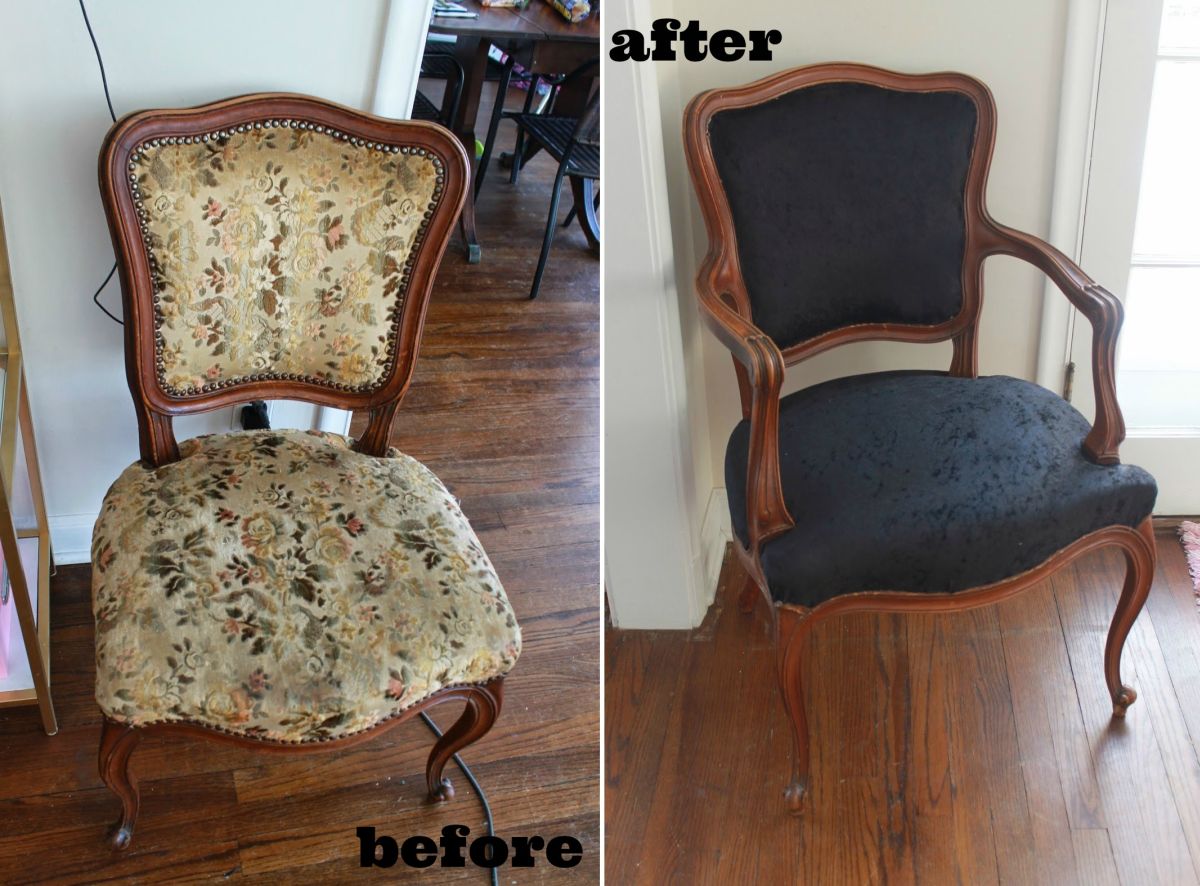
 Beginners Guides2 weeks ago
Beginners Guides2 weeks agoHow to Reupholster a Chair With Buttons
-

 Vetted2 weeks ago
Vetted2 weeks ago15 Best Mesh Laundry Bags to Keep Your Delicates Safe and Sound
-

 Vetted4 weeks ago
Vetted4 weeks ago15 Best Fillers for Concrete Cracks – Expert Recommendations and Reviews
-

 Beginners Guides1 week ago
Beginners Guides1 week agoHow to Bake Acrylic Paint on Ceramic Mugs









